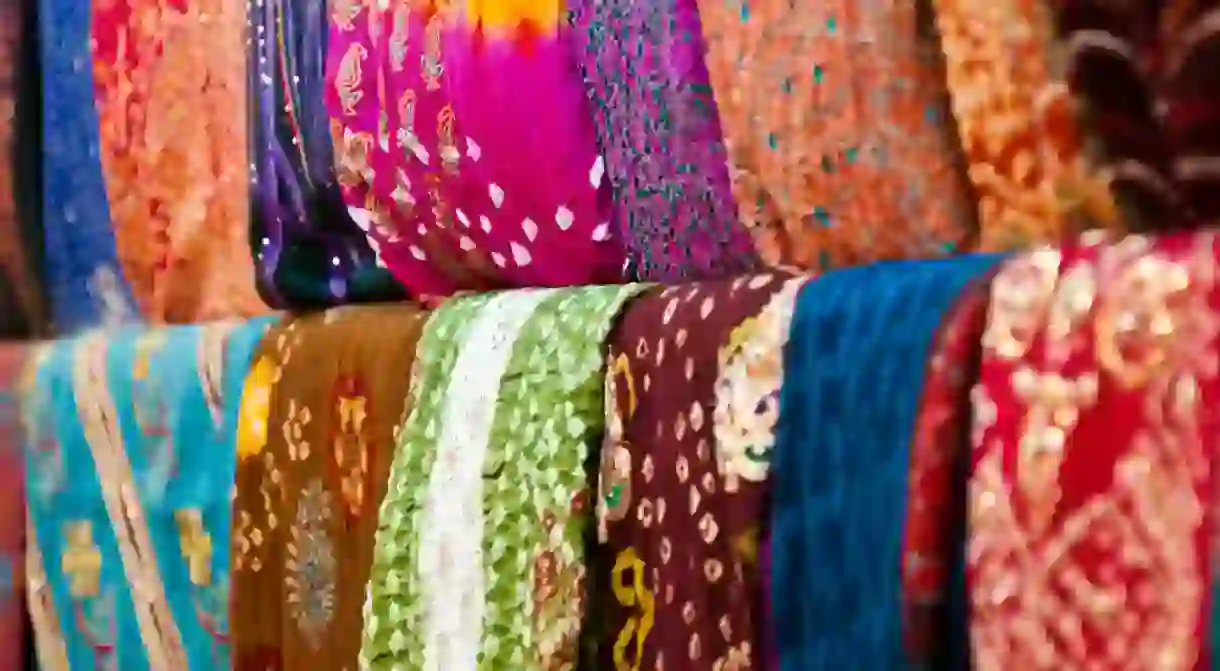An Introduction to Rajasthan's Traditional Dress

Rajasthan’s rich culture is exhibited via its majestic forts, royal palaces, vibrant festivals, delicious food, performing arts, and even traditional costumes. The traditional outfit is colourful and elaborate, and is still proudly worn by Rajasthanis. Here’s an introduction to Rajasthan’s traditional dress.
Women’s Traditional Dress
Traditional attire for Rajasthani women is ghagra, choli (also called kanchli or kurti) and odhni. The ghagra is a full-length, embroidered and pleated skirt, which comes in a variety of colours, prints and fabrics, such as silk, cotton, georgette and crêpe. Of all the various prints, the laharia, bandhej, tie ‘n dye, chundri and mothra are the most widely worn. To impart royal elegance, antique borders and Jaipuri gota-patti work are incorporated to the ghagra.
The kanchli, choli or kurti are the upper-body wear. These are colourful and intricately designed and shaped as per the specific body measurements. For an ethnic touch, they are embellished with mirror-work, beads and sequins, coral and shells, and creative-cut work.
The odhni, or chunar, is a long piece of cloth, approximately 2.5 meters in length and 1.5 meters in width, and is worn as a veil. Made of light printed or patched fabric, it features beautiful embroidery, beadwork or other embellishments. There are different ways of wearing it, but the most traditional way is tucking one corner inside the ghagra, resting the middle portion on the chest and draping the end part over each shoulder and above the head, covering it gracefully.
Women’s Traditional Accessories

Elaborate necklaces, like Jadau sets, aad (chokers) and Raani Har (long necklaces to the belly button) are worn around the neck, especially by women from affluent families.
The women of tribal groups such as Bhil, Meena or Garasia prefer wearing brass, silver or white metal ornaments. Kaanbali or surliya (earrings), nathani (nosepins), bajubandh (armlets), rakhdi or borla (maang tikkas), tagdi or kardhani (belly or waist chains), payal (anklets), bangadi (bangles), bichuwa (toe rings) and finger rings are also worn to complete the ensemble.
Men’s Traditional Dress
The traditional outfit for Rajasthani men is dhoti and angarkha, or pyjama-kurta. The dhoti is a long piece of cloth tied around the waist and wrapped around like a loin-cloth between the legs. It is paired with angarkha, a type of robe characterized by an inner panel that covers the chest. The angarkha is usually worn by the wealthy class. However, some tribal and pastoral communities have adopted it, reserving it for special occasions. The length and flare of this garment varies. The royal Rajput clan prefers wearing flared, ankle-length angarkha, while other communities and tribal groups wear knee-length or shorter versions. For everyday use, men wear angarkhi (or, puthia), which is short and tied with laces, not buttons.
The pyjama is like track pants, and generally made from cotton. It is paired with kurta or mufti, which is a loose-fitting shirt. While it usually goes down to the knees, today Rajasthani men may take liberties with the length and pattern of this traditional costume.
The traditional outfit is incomplete without pagari (turban or headgear), which is generally two meters long and 0.2 meters wide. It comes in a variety of colours, shapes and sizes, and is considered the pride and honour of men. There are different ways of wearing it, each defining a specific region or caste. Specially designed pagaris, called safas (short and broad in size), are worn during weddings and festivals, while everyday pagaris are rustic.
Men’s Traditional Accessories
To complete the ensemble, men wear round-shaped balis or studs on their earlobes and crystal beaded or semi-precious stone neckpieces. Influential families and royals also wear kambarbandh (waistbands) and patka, a piece of cloth hung over the shoulder.
Footwear for Men and Women
Both men and women in Rajasthan wear jootis or mojaris. They are leather shoes made up of sheep, camel or goat skin, complete with intricate embroidery and embellishments. While traditional footwear is usually black or brown, nowadays much more fashionable multi-coloured slip-ons are also available.
Check out these amazing tours and excursions in Rajasthan.













